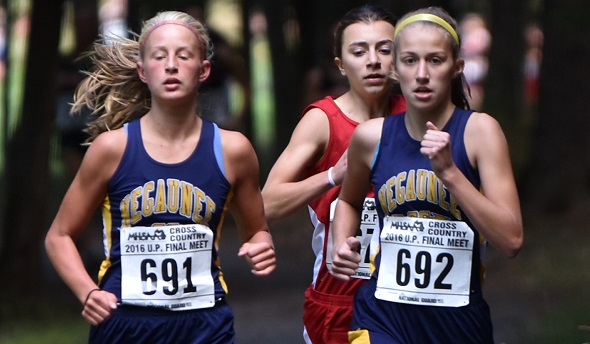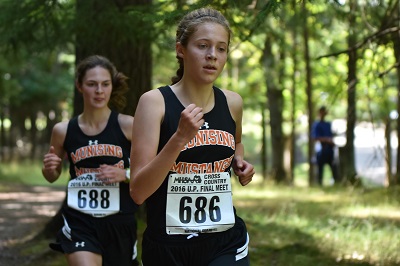
Preview: Be Prepared for Speedy Start
October 20, 2017
By Geoff Kimmerly
Second Half editor
Of 30 runners who finished among the top 10 in an Upper Peninsula Girls Cross Country Final last season, 18 will be returning for another championship opportunity Saturday at Pictured Rocks Golf Club in Munising.
And if that’s not sign enough that the competition will be high caliber, consider this – the two reigning champions returning will face off in the first race.
This year’s Finals kick off with the Division 3 girls, and it’s hard to imagine a better opener for reasons discussed more below – including what could be the day’s strongest individual and team competitions for either the girls or boys.
Races begin at 11 a.m. and finish with the Division 1 boys at 1:30 p.m. Check back Saturday evening for coverage of all six Upper Peninsula Finals, and see below for more teams and individuals to watch.
Division 1
Reigning champion: Sault Ste. Marie
2016 runner-up: Marquette
2017 top-ranked: 1. Sault Ste. Marie, 2. Marquette, 3. Negaunee.
This season’s Sault Ste. Marie team lines up much differently from the one that claimed the program’s first MHSAA title a year ago – when all six runners finished among the top 13. But sophomore Shelby Eavou is back after finishing ninth and sophomore Nicky Kucharczyk joins her after coming in 12th, and two freshmen have entered the mix with Haleigh Knowles topping the team with a seventh-place at the prestigious El Harger Invitational in September. Knowles and her teammates will have to fend off a Marquette team that returns only two of seven from last year’s Final but is led by sophomore Ericka Asmus, who finished 10th and won the Great Northern Conference meet last week. Negaunee is paced by its top three from last year’s team that finished sixth, including sophomore Emily Paupore and senior Clara Johnson – who came in third and fourth, respectively, among individual placers.
Other individuals: In addition to the five from last season’s top 10 who will return this weekend, Escanaba freshman Nicole Kamin could be one to watch Saturday and for the next three Finals after she finished second to Asmus at the GNC finale. Calumet freshman Clarity Gipp also should be in the mix over these next four Finals; she finished second at the Western Peninsula Athletic Conference meet and won one of the league jamborees this fall.
Division 2
Reigning champion: Ishpeming
2016 runner-up: Munising
2017 top-ranked: 1. St. Ignace, 2. Ishpeming, 3. Hancock.
St. Ignace is fresh of a sweep of Eastern Upper Peninsula Conference jamborees and is predicted to break Ishpeming’s three-year hold on the Division 2 title. The Saints finished fourth last season and return only two of five runners from that race, but they placed the top four runners at that final EUP jamboree as freshman Hallie Marshall led the way. The Hematites won last year in part on the strength of depth with all seven runners placing between ninth and 20th. Five of those seven are back, led by senior Kayla Kaukola and junior Brooke Johnson, who led the way in 2016 coming in ninth and 10th, respectively. Hancock returns its top five and six of its seven runners from last season’s third-place finish, with sophomore Mackenna Nuttall looking to break into the top 10 after coming in 11th a year ago.
 Individuals: With Munising and its champion and runner-up from last year’s race moving to Division 3 this season, only four of the 2016 top 10 are back. Finishing ahead of Kaukola and Johnson last year were Ironwood’s Emily Carey in fifth and Iron River West Iron County’s Taylor Clark in seventh; both are juniors this season.
Individuals: With Munising and its champion and runner-up from last year’s race moving to Division 3 this season, only four of the 2016 top 10 are back. Finishing ahead of Kaukola and Johnson last year were Ironwood’s Emily Carey in fifth and Iron River West Iron County’s Taylor Clark in seventh; both are juniors this season.
Division 3
Reigning champion: Cedarville
2016 runner-up: Chassell
2017 top-ranked: 1. Chassell, 2. Munising, 3. Engadine.
Cedarville ended Chassell’s two-year winning streak last season, edging the Panthers by 12 points. But Chassell has stormed back this fall and is led by five runners from last year’s lineup including reigning UPD3 champion Lela Rautiola, now a junior, and freshman Gwen Kangas, who came in ninth last year as an eighth-grader. Munising will certainly provide a challenge after finishing second in UPD2 last year. The Mustangs have five of last year’s seven runners in the lineup for this weekend, led by last season’s UPD2 individual champion, senior Alyssa Webber, and runner-up now-junior Madeleine Peramaki. Those two and Rautiola finished within six seconds of each other at the El Harger Invitational, Peramaki the fastest of the three. Cedarville does return three runners who placed among the top 10 and four of its seven total from last year, and could sneak into contention despite being an honorable mention in the latest UPD3 ranking.
Individuals: Webber’s 19:59 last year would’ve won the race by 13 seconds, and Peramaki would’ve placed fourth individually. Cedarville adds junior Caroline Freel, sophomore Lily Freel and freshman Cassidy Barr into the mix after they crossed sixth, eighth and 10th in UPD3, respectively, last season. Rock Mid-Peninsula sophomore Daisy Englund is back after finishing seventh, and Eben Junction Superior Central sophomore Danika Walters will look to move up after finishing fourth. And as mentioned, Rautiola is the reigning champ and Kangas was ninth – making it nine runners total competing in this race who were top-10 in one of the Finals last season.
PHOTOS: (Top) Negaunee’s Clara Johnson (691) and Emily Paupore (692) lead Marquette’s Ericka Asmus during the Aug. 31 Dale Phillips Invitational at Marquette. Asmus would end up winning the race, with Johnson second and Paupore third. (Middle) Munising’s Madeleine Peramaki (686) and Alyssa Webber (688) came in fourth and fifth, respectively, at the Phillips Invitational. (Photos by Cara Kamps.)

MHSAA Vault: MIS Rose to Challenges to Host 2020 LP Finals
By
Rob Kaminski
MHSAA benchmarks editor
November 12, 2021
The “MHSAA Vault” features stories from past publications and other documents in the MHSAA Library. This issue takes a look at the MHSAA Cross Country Finals at Michigan International Speedway, which celebrated 25 years in 2020 – although it was an event that nearly didn’t happen last fall …
In 1996, the MHSAA and Michigan International Speedway began a partnership the changed the course of the Lower Peninsula Cross Country Finals – quite literally.
The land in and around the track at Brooklyn would host the Finals for all classes of runners in one place on one day, an annual festival of nearly 2,000 runners competing for the MHSAA’s top honors.
Even skeptics – and there were several among running purists who thought the course was too flat, for example – can’t deny the results.
Finals attendance nearly doubled in that first year, and crowds in excess of 10,000 have enjoyed a day of racing several times, including a record 12,153 in 2011.
Enthusiastic crowds were the norm in recent years, with 11,232 in 2017, and nearly 11,000 in 2018 (10,989) and 2019 (10,873).
In fact, attendance failed to reach at least 8,000 only twice since the move to MIS.
Of course, last year was an exception, when attendance was limited to 1,000 spectators per session due to the COVID-19 Pandemic. Fans also were restricted to the grandstands rather than following the action throughout locations on the course.
To reduce the number of runners in each race, the event was spread over two days, with each Division being run in two separate “sections” with times then combined at the end to determine team and individual champions.
While not ideal, the end result was another year of fantastic efforts at MIS – both from student-athletes and those behind the scenes.
“Even at the last hour, less than a week ahead of the Finals, we were closer to not having the Finals than we were to having them,” said MHSAA Assistant Director Cody Inglis, who coordinates the cross country postseason. “Rumors and challenges of mandated shutdowns, testing and other requirements were being discussed and caused a lot of unknowns. Even at the Regional level, we had schools, Regional courses and hosts shutting down their facilities; we had to relocate four Regionals 48 hours prior to race times. That scenario just could not happen at the Finals level where far more runners and much more travel would be involved.”
Among the many last-minute hurdles was the edict from NASCAR – which owns MIS – that all persons on site be temperature checked upon entry. That meant securing thermometers that were easy to operate in short order, along with personnel necessary to conduct the readings.
The attendance limitations certainly helped to implement the temperature screening, but brought their own issues.
“Limiting spectators was not a popular decision, but it really was the only way to have a race,” Inglis said. “We were taking direction and working with policies and protocols from the MDHHS, the Governor’s office, Lenawee County Health Department, MIS and NASCAR.”
Part of the solution was to utilize the grandstands as a “barrier” between participants and spectators. The reduced number of fans were dispersed over thousands of seats while still allowing them the chance to watch their student-athletes compete.
“It wasn’t the same, it wasn’t easy or perfect, but it was what we had to do to have a race,” Inglis said. “Separating the Finals into two days and different sections also allowed us to spread out the event and limit the number of people on site at any one time. This was a key part of the plan and worked well even though it separated races within a Division.”
The MHSAA, MIS and the cross country community never lost focus of the main goal: a culmination of the season for the student-athletes, who deserved something last year more than ever. And, more than ever, MIS once again displayed its advantage as a venue that could adapt to the fluid nature of the times to pull off the event.
“There were some thoughts of using four different sites, but as we learned during the Regionals, the climate of things was so tenuous from one area of the state to another that we couldn’t be 100-percent certain that there wouldn’t again be last-minute cancelations,” Inglis said. “MIS was wonderful to work and collaborate with, and was the best option to get it done. It was never mentioned once publicly about the possibility of not having the Finals – only how we could best do it under uncharted conditions.”
The moving parts and ever-changing scenarios created more complexity than ever in finalizing a season, but every decision was made with the complete desire to conduct the Finals as close to normal as possible.
“I firmly believe that a finish to the season, no matter the differences in race formatting and fan experience, was something everyone would have taken when the season began in August,” Inglis said.
Indeed, the finish line in Year 25 at MIS might have been the most gratifying of them all.

